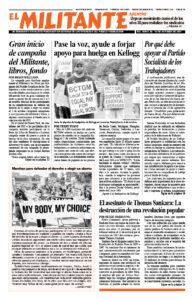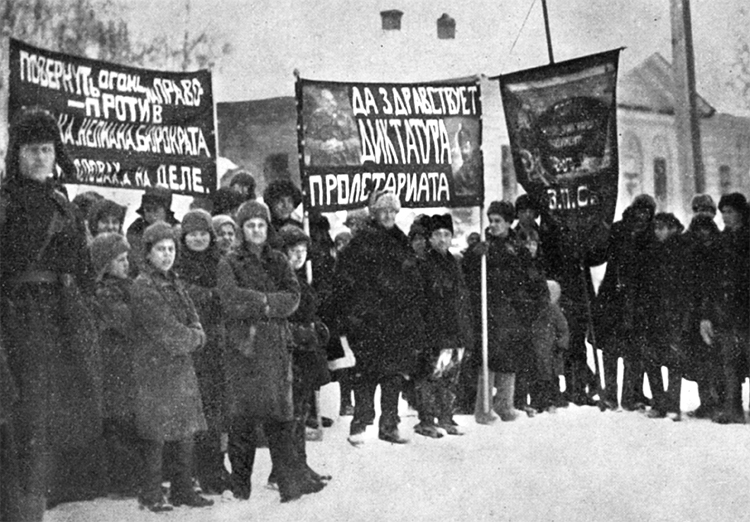Samizdat, Voices of the Soviet Opposition, is one of Pathfinder’s Books of the Month for October. It contains clandestine writings circulated in the Soviet Union, from the late 1920s to the 1970s, challenging the anti-working-class Stalinist regime and its repression. The excerpt below is from “Vorkuta (1950-53): Oppositional Currents and the Mine Strikes” by Brigitte Gerland, describing her opposition to Stalinism in Eastern Europe after World War II. She joined the Communist Party in East Germany but quickly became disillusioned. She was arrested by Moscow’s secret political police and framed up as a “British spy.” She spent eight years in Stalin’s prison camps, six in the Arctic Circle. The Militant serialized her account in 1955. Copyright © 1974 by Pathfinder Press. Reprinted by permission.
I begin this article with a quotation from the first manifesto issued by the Communist resistance group which calls itself by the significant name of “Istinny Trud Lenina” (ITL, or Lenin’s True Works). My purpose is to demonstrate by means of this document how this group aspires to continue the line of Bolshevism.
“What are the aims of the Communist resistance movement in the USSR? They are:
“To wage a struggle against the system of government which rests on the bureaucracy and the army and which can be eliminated only by a political revolution.
“To install full democracy in the shape of a workers’ and peasants’ soviet government, the first stage toward the classless society.
“The foundations of a socialist soviet republic are necessarily constituted by the soviets of industrial plants and of collective farms, which exercise legislative, executive, and judicial powers; and which are elected by all the toilers, workers and peasants, through universal suffrage and the secret ballot. In cases of proven incompetence, any member of the soviet is subject to recall through the same electoral procedure; and the term in office is not fixed in advance by a given legislative period.
“Each industrial plant belongs to the union of its particular branch of industry, which is headed by the union soviet. It is elected by the soviets of all the plants in that union. The union soviets together then elect the supreme workers’ soviet in which the highest legislative and executive authority resides.
“The collective farms, on the other hand, are joined together by districts; and the peasant soviets, elected by each cooperative, elect district soviets, which, in turn, elect the supreme peasants’ soviet in which, jointly with the supreme workers’ soviet, the highest powers reside.
“Professional bureaucrats must be replaced by workers’ and peasants’ committees which carry out all the administrative, economic, and social tasks required for the maintenance and growth of the collective society.
“The permanent standing army with its corps of career officers must make way for a workers’ and peasants’ militia, whose only superiors shall be soldiers’ soviets elected by the armed forces.
“To attain these objectives, it is necessary to sweep away the monstrous oligarchy of all-powerful bureaucrats and ambitious militarists whose sole interest is to exploit the Soviet people and expropriate them of all political rights in order thus to remain in power. Only their overthrow will clear the road to communism.”
This manifesto was drawn up in 1948 by a dozen Moscow students, and then reproduced and circulated secretly at the university. The young Leninists had no contact of any kind with the old Opposition because all of the old Oppositionists had been liquidated by Stalin and his henchmen. The theses of these young Leninists attracted so many students to them that in a few months the ITL already counted hundreds of members and had adherents not only in Moscow but also in the universities of Leningrad, Kiev, and Odessa.
Despite the jeopardy to their lives and livelihoods at so early an age and so definitively, the youth who rallied to this underground organization saw their main enemy not in Stalin, as a personality, but in the bureaucratic, totalitarian system he incarnated. When the dictator, after his long reign, finally died, an event no one regretted, they likewise harbored no illusions concerning his possible successors. They expected nothing from the much ballyhooed “liberalization,” since it could not, in the existing circumstances, signify anything else but a move to the right and a further aggravation of the already intolerable social contradictions. …
[T]he Communist students made it clear that broad layers of the ruling bureaucracy would work, might and main, to consolidate their political power on the economic plane; that is to say they would readily promote private capitalist tendencies, in order, with their aid, to transform themselves from more or less dependent, state-employed persons into independent proprietors; and in this way, convert the unstable layer of exploiters to which they belonged into a ruling class resting economically upon private property relations.
From this standpoint … liberalization and reform meant a threat to the socialist economy and to the Soviet proletariat bound up with this economy, rather than any improvement in the lot of the Soviet toilers as a whole.
No member of the resistance movement would entertain even for a moment the illusion that the new ruling clique would go so far in its “liberalization” as to allow the opposition a chance to express itself, because any such tolerance would spell suicide for the ruling layer; that was something even the most extreme optimist had to discount.
Among the basic tenets held by the Leninist students is this, that the transition to communism can be achieved only by the working classes of all countries, acting in common, in a revolution embracing the whole world. That is why they categorically condemned the Stalinist policy of nationalistic expansion.
Opposition members condemned all the annexations by the Soviet Union perpetrated after the war, because these annexations run counter to the principle of national self-determination so passionately defended by Lenin. They criticized Soviet policy in the buffer countries and East Germany as incompatible with Marxist perspectives.


